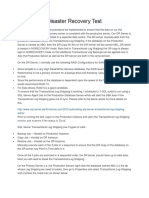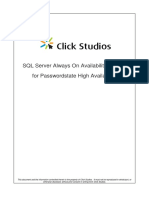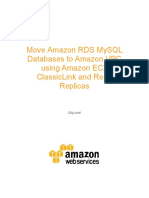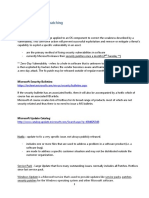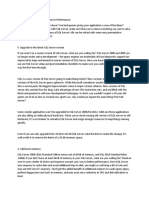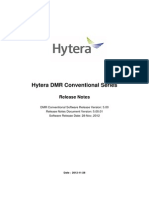SQL Cluster On Windows Failover Cluster
Uploaded by
shyco007SQL Cluster On Windows Failover Cluster
Uploaded by
shyco007SQL Cluster on Windows Failover Cluster
Combining AlwaysOn AG with Failover Cluster Instances
In this article we'll look at how AlwaysOn availability groups combine with Failover Cluster Instances. We'll look individually
at Failover Cluster Instance composition, Windows Server Failover Clusters and AlwaysOn availability groups, what they are
and how they interact. For the purposes of this article the following are used;
FCI
A failover cluster instance of SQL Server
AO
Always On availability groups, the new SQL Server 2012 feature
WSFC
Windows Server Failover Cluster, a feature of the Windows 2008 operating system
NIC
Network interface card
SAN
Storage area network
LUN
Logical unit number
For many years now Windows Server Failover Clusters and Failover Cluster Instances have been a popular configuration for
highly available SQL Servers. Later, with SQL Server 2005 came database mirroring. Although mirroring was limited, it offered
an extra level of redundancy. Now with SQL Server 2012, we take a huge leap forward in highly available SQL Servers.
AlwaysOn is the new high availability feature in SQL Server 2012 and provides the ability to create multiple copies of a highly
available database. In order for AlwaysOn to provide this level of availability it utilizes the functionality
within Windows Server Failover Clusters. It doesn't by any means replace Failover Cluster Instances of SQL Server, rather, it
shares the use of the core technology presented by the Windows operating system. Just as you could with database
mirroring, you have the option to combine an AlwaysOn availability group with a SQL Server Failover Cluster Instance, but it
adds a great deal of complexity due to the strict AO implementation rules and the sharing of the Windows operating system
failover cluster feature.
In this article we're going to look at 2 different scenarios, the first provides a basic AlwaysOn configuration, the second will
show how an FCI can combine with AlwaysOn groups to provide an extremely resilient high availability option for your SQL
Server system.
Before we start, and to help us on our way, let's look briefly and individually at each of these technologies to understand a little
more about them.
What is a Windows Server Failover Cluster?
Windows Server Failover Clusters are a feature of the Windows server 2008 operating system. They provide the ability to
combine multiple computer nodes (physical and\or virtual) to service a set of applications for high availability, in this case a
SQL Server instance. The application is made highly available by presenting to clients a virtual access point comprising a
unique IP address and a unique computer name or "virtual network name". These become resources in an application group
and are passed between participating nodes like tokens.
The computer nodes use shared storage, which is presented to each node, usually from a SAN. The disks are added to
clustered application\group and will failover between the nodes when the group is moved (either manually or through
automatic failover). Throughout normal operation, only one node may obtain access to the storage disks at any one time (the
node that owns the particular resources) to avoid volume corruption, this is also true for all of the remaining resources in the
cluster group too. Disk access is controlled by the cluster service once the disks have been added as cluster resources.
The WSFC requires some form of mediation to control cluster resource ownership, and uses Quorum to maintain cluster
stability. In Windows Server 2008 WSFC, this Quorum takes the form of a node voting system with the majority required to
maintain Quorum. You may also use additional quorum resources in the form of a disk for localized clusters or a remote file
share for multi-site clusters.
A critical hardware failure of the active computer node would result in the loss of group service and would automatically start
the group on an available partner node. At a high level, the client access point details are transferred along with any disk and
service resources, etc. to a failover partner node. A failover of the clustered instance causes disconnection of client
connections, these may then reconnect once the service is available on a partner node.
Common failures usually are;
Public NIC or network failure
Power supply failure
Motherboard failure
CPU failure
What is a Failover Cluster Instance?
A Failover Cluster Instance is an instance of SQL Server, default or named, that has been installed onto a WSFC as a clustered
application. The clustered application typically has the following resources as a minimum;
IP address
Network name
Shared disk(s)
SQL Server service
SQL Server agent service
A clustered instance of SQL server will utilize any shared storage that has been presented to the Windows Server
Failover Cluster nodes, usually this storage will take the form of LUNs presented from a SAN. A Failover Cluster Instance of
SQL Server is deployed by launching the "New SQL Server Failover Cluster Installation" wizard on the first computer node
that will participate in the FCI. Once this has been performed you would then launch the "Add Node to a SQL Server Failover
Cluster" wizard on any computer node in the WSFC that you wish to participate in the new SQL Server FCI. For Standard
edition of SQL Server you are limited to 2 nodes, Enterprise and upwards support the OS maximum (8 nodes in Windows
2003 and 16 nodes in Windows 2008).
Note: Standard edition limits the FCI to 2 nodes but this does not dictate how many nodes have membership of the Windows
cluster, it is merely at the installer level.
What is an AlwaysOn Availability Group?
An AlwaysOn Availability Group, is a group of one or more databases configured on a primary replica (or SQL Server
instance) for high availability. This will typically include one or more further replicas which will service a copy of the highly
available database(s). Partner databases may be either readable or standby and may also use either asynchronous or
synchronous commit modes.
In AlwaysOn a replica refers to an instance of SQL Server that is participating in the AlwaysOn availability group.
AlwaysOn relies on the WSFC core functionality to achieve the high availability that AO offers, but does not require any of
the following shared resources associated with an FCI.
Shared disks
Shared IP address
Shared network name
Shared SQL Server and SQL Server agent resources
There is one exception to this rule, when creating an AlwaysOn group listener this will create a set of resources shared by
the AO group replicas, but note that this application\cluster group has no relation to a Failover Cluster Instance.
If you are using a listener for your AO group you are able to provide a central client access point for entry into the availability
group, this provides a great deal of resilience when used in your application connection strings.
AlwaysOn is a feature configured at the individual service level by using SQL Server Configuration Manager. A computer
node MUST first be a member of a valid WSFC before you may enable the AlwaysOn service feature. Availability
replicas MUST be situated on separate physical nodes. Given this, in an example, INST1 must reside on Node1 and INST2
must reside on Node2. You cannot install INST1 and INST2 on to Node1 and configure an AOgroup.
For a basic AlwaysOn configuration, each node has local disk storage and non-clustered instances of SQL Server
installed. Ultimately, AO removes the storage single point of failure that is common place with shared disks. The nodes are
completely standalone apart from their membership of a valid Windows Server Failover Cluster.
Now that we have a little background we may start to look at how these technologies interact.
How Do Failover Cluster Instances Integrate With AlwaysOn Groups?
We first need to understand how this affects the WSFCs.
All participating nodes in an AlwaysOn group need to be joined to the same WSFC. Yes, that means that the servers must be
joined to the same Windows domain to participate in the same WSFC. WSFCs, Failover Cluster Instances and AlwaysOn
groups do not span Windows domains.
In a basic example of an AlwaysOn configuration we have the following node and IP address configurations:
Computer Nodes
AONode1.UKTrading.co.uk
AONode2.UKTrading.co.uk
192.168.1.41
192.168.1.42
WSFC Joined
SQLCluster01.UKTrading.co.uk
192.168.1.45
Non Clustered SQL Server Instances
AOINST1 on AONode1
AOINST2 on AONode2
AlwaysOn Group
SQLAOGrp1
AlwaysOn Listener
SQLAOListener.UKTrading.co.uk
192.168.1.46
How does this look?
The following diagram shows a graphical representation of how your system would look
For this scenario, each cluster node listed above has the following local drive storage and a single non clustered instance of
SQL Server installed.
The instances installed are;
AONode1\AOINST1
AONode2\AOINST2
The locally attached disks in use on each node are;
C: = 78GB
D: = 300GB
E: = 300GB
F: = 300GB
The key here is that both nodes have separate storage resources to each other but are both joined to the Windows cluster
shown below;
SQLCluster01.UKTrading.co.uk
The AlwaysOn group has a listener using the virtual network name and IP detailed above. This would represent a standard
AlwaysOn configuration and does not use a SQL Server FCI or shared storage resources.
Remember, the goal in AlwaysOn is to remove the storage single point of failure by utilizing separate storage resources
between participating computer nodes.
Now let's take our second scenario to include a corporate FCI into our AlwaysOn configuration.
The architect team have directed that the primary SQL server instance must be hardware protected on the primary site and
there should be provision for read only replicas for reporting and maintenance. The following configuration incorporates
an FCI to provide hardware protection on the primary site. These are the node and IP address configurations in use;
Computer Nodes
AONode1.UKTrading.co.uk
AONode2.UKTrading.co.uk
AONode3.UKTrading.co.uk
AONode4.UKTrading.co.uk
192.168.1.41
192.168.1.42
192.168.1.43
192.168.1.44
WSFC Joined
SQLCluster01.UKTrading.co.uk
192.168.1.50
Cluster SQL Server Instance
SQL-CL-INST\SiteLive
192.168.1.51
Non Clustered SQL Server Instances
AONode1\DRRepl
AONode2\CLMaint
AlwaysOn Group
SQLAOGrp1
AlwaysOn Listener
SQLAOListener.UKTrading.co.uk
192.168.1.46
How does this look?
The diagram below shows a graphical representation of the AlwaysOn availability incorporating a SQL Server Failover Cluster
Instance.
Each server has the following locally attached drive storage.
C: = 78GB
D: = 300GB
E: = 300GB
F: = 300GB
In addition to the above locally attached disks, AONode3 and SAONode4 have the following shared LUNs attached from
a SAN.
G: = 500GB
H: = 250GB
L: = 300GB
We have our WSFC titled "SQLCluster01.UKTrading.co.uk", this is the cluster entry point for all 4 nodes and each server is
joined to this cluster.
A Failover Cluster Instance of SQL Server has been installed first to AONode3 and then AONode4 has been added as a
failover partner node, the instance is titled
"SQL-CL-INST\SiteLive" as detailed above. The FCI is using the following shared drives
G:
H:
L:
2 non clustered instances of SQL Server have been deployed as follows:
AONode1 has an instance named "DRRepl"
AONode2 has an instance named "CLMaint"
We have created an availability group titled SQLAOGrp1 on the clustered SQL Server instance called SQL-CL-INST\SiteLive
and we include the following instances as replicas
AONode1\DRRepl
AONode2\CLMaint
This completes our AlwaysOn availability group incorporating FCI's.
Note here that AONode3 and AONode4 are part of the same Windows Server Failover Cluster as AONode1 and AONode2,
only AONode3 and AONode4 are set up as failover partners for the clustered instance SQL-CL-INST\SiteLive (AONode1 and
AONode2 have not had the SQL Server "Add node" wizard executed upon them).
As you can see, incorporating an FCI into an availability group requires an increased number of cluster nodes to ensure that
the availability replicas meet the standard requirement whereby, each replica (SQL Server instance) must reside on a
separate physical node. Understanding the different technologies allows you to pull them together to create one incredibly
resilient SQL Server system.
Creating yourself a virtual test system will give you a better grasp on failover clusters and availability groups and as always
have fun in your work. Post back if you're still unsure and I'll help all I can.
You might also like
- Configure Always On Availability Group in Azure VM Manually100% (1)Configure Always On Availability Group in Azure VM Manually32 pages
- Installing and Configuring Always On Availability Groups (Windows)No ratings yetInstalling and Configuring Always On Availability Groups (Windows)42 pages
- Building A HA and DR Solution Using AlwaysON SQL FCIs and AGs v1No ratings yetBuilding A HA and DR Solution Using AlwaysON SQL FCIs and AGs v142 pages
- Always On Availability Group EnhancementsNo ratings yetAlways On Availability Group Enhancements44 pages
- An Introduction To SQL Server ClusteringNo ratings yetAn Introduction To SQL Server Clustering10 pages
- DRBD-Cookbook: How to create your own cluster solution, without SAN or NAS!From EverandDRBD-Cookbook: How to create your own cluster solution, without SAN or NAS!No ratings yet
- Performance Monitoring Alwayson Availability Groups: Anthony E. NocentinoNo ratings yetPerformance Monitoring Alwayson Availability Groups: Anthony E. Nocentino35 pages
- Microsoft Load Balancing and ClusteringNo ratings yetMicrosoft Load Balancing and Clustering23 pages
- (AWS) Microsoft WSFC and SQL AlwaysOn Quick StartNo ratings yet(AWS) Microsoft WSFC and SQL AlwaysOn Quick Start47 pages
- Windows Cluster Interview Questions and AnswersNo ratings yetWindows Cluster Interview Questions and Answers6 pages
- SQL Server AlwaysOn Availability GroupsNo ratings yetSQL Server AlwaysOn Availability Groups28 pages
- KDSSG Center For Excellence: SQL Server 2005 DBA Installation ChecklistNo ratings yetKDSSG Center For Excellence: SQL Server 2005 DBA Installation Checklist5 pages
- Creating An Active-Active SQL Cluster Using Hyper-V - Virtualized StorageNo ratings yetCreating An Active-Active SQL Cluster Using Hyper-V - Virtualized Storage58 pages
- Steps To Configure SQL Server Availability GroupsNo ratings yetSteps To Configure SQL Server Availability Groups15 pages
- Top 65 Windows Server Interview QuestionsNo ratings yetTop 65 Windows Server Interview Questions11 pages
- Deploying Highly Available AD FS 3.0 Solution in Windows Azure For Single Sign-On With Office365No ratings yetDeploying Highly Available AD FS 3.0 Solution in Windows Azure For Single Sign-On With Office365199 pages
- Database Mirroring Questions and AnswersNo ratings yetDatabase Mirroring Questions and Answers9 pages
- Five Things That Fix Bad SQL Server PerformanceNo ratings yetFive Things That Fix Bad SQL Server Performance3 pages
- SQL Server Interview Questions - Basic SQL Server Interview QuestionsNo ratings yetSQL Server Interview Questions - Basic SQL Server Interview Questions9 pages
- Windows Server Troubleshooting - The RPC Server Is Unavailable - TechNet Articles - United States (English) - TechNet WikiNo ratings yetWindows Server Troubleshooting - The RPC Server Is Unavailable - TechNet Articles - United States (English) - TechNet Wiki9 pages
- Clustering SQL Server Active-Active-PassiveNo ratings yetClustering SQL Server Active-Active-Passive29 pages
- Module 2. VSphere and Virtualization OverviewNo ratings yetModule 2. VSphere and Virtualization Overview32 pages
- Complete Guide To Vmware Clustering EbookNo ratings yetComplete Guide To Vmware Clustering Ebook134 pages
- 70-764 - Administering A SQL Database InfrastructureNo ratings yet70-764 - Administering A SQL Database Infrastructure8 pages
- Planning and Implementing High AvailabilityNo ratings yetPlanning and Implementing High Availability32 pages
- Marketing Services Center: Bluemine - Analysis For The Database Software Choice JUNE 11, 2018No ratings yetMarketing Services Center: Bluemine - Analysis For The Database Software Choice JUNE 11, 201810 pages
- VMware Cloud Foundation On Dell EMC VxRail Admin GuideNo ratings yetVMware Cloud Foundation On Dell EMC VxRail Admin Guide104 pages
- Dell EMC VxRail Vcenter Server Planning GuideNo ratings yetDell EMC VxRail Vcenter Server Planning Guide15 pages
- Deploy and Configure A Platform Services ControllerNo ratings yetDeploy and Configure A Platform Services Controller8 pages
- XenApp & XenDesktop Pre-Sales Technical WorkshopNo ratings yetXenApp & XenDesktop Pre-Sales Technical Workshop307 pages
- Vsphere Esxi Vcenter Server 551 Security Guide0% (1)Vsphere Esxi Vcenter Server 551 Security Guide182 pages
- SIMOS.3003.IKEv2.FlexVPN.SVTI.with.PSK.v001No ratings yetSIMOS.3003.IKEv2.FlexVPN.SVTI.with.PSK.v00111 pages
- Archivo para Cortes DOCSIS (Recuperado Automáticamente) (Recuperado Automáticamente)No ratings yetArchivo para Cortes DOCSIS (Recuperado Automáticamente) (Recuperado Automáticamente)33 pages
- Jboss Soa Platform 4.2 - Deep Dive: Burr Sutter February 2008No ratings yetJboss Soa Platform 4.2 - Deep Dive: Burr Sutter February 200841 pages
- Gmail Id Password Web Site Name Status PNo ratings yetGmail Id Password Web Site Name Status P16 pages
- I2C Master/Slave Core Verification Plan: TB ConfigurationNo ratings yetI2C Master/Slave Core Verification Plan: TB Configuration4 pages
- DMR Tier 2 - Software Release Notes - R5.0 - enNo ratings yetDMR Tier 2 - Software Release Notes - R5.0 - en23 pages
- Introduction To Perl/CGI Training: Class OverviewNo ratings yetIntroduction To Perl/CGI Training: Class Overview3 pages
- CTX127161 - How To Replace A Network Interface Card in A XenServer Host - Citrix Knowledge CenterNo ratings yetCTX127161 - How To Replace A Network Interface Card in A XenServer Host - Citrix Knowledge Center2 pages
- Icaict202a Short Answer Questions - AnswersNo ratings yetIcaict202a Short Answer Questions - Answers5 pages
- Unmanaged Versus Managed Switches: Podcast TranscriptNo ratings yetUnmanaged Versus Managed Switches: Podcast Transcript3 pages
- PEAK-System - CAN Basics & PCAN-Explorer 6 - India2019100% (1)PEAK-System - CAN Basics & PCAN-Explorer 6 - India201961 pages
- 2018 Sundray 2 Wireless Data Forwording - v3.6.7No ratings yet2018 Sundray 2 Wireless Data Forwording - v3.6.739 pages
- Configure Always On Availability Group in Azure VM ManuallyConfigure Always On Availability Group in Azure VM Manually
- Installing and Configuring Always On Availability Groups (Windows)Installing and Configuring Always On Availability Groups (Windows)
- Building A HA and DR Solution Using AlwaysON SQL FCIs and AGs v1Building A HA and DR Solution Using AlwaysON SQL FCIs and AGs v1
- DRBD-Cookbook: How to create your own cluster solution, without SAN or NAS!From EverandDRBD-Cookbook: How to create your own cluster solution, without SAN or NAS!
- Oracle SOA Suite 11g Administrator's HandbookFrom EverandOracle SOA Suite 11g Administrator's Handbook
- Performance Monitoring Alwayson Availability Groups: Anthony E. NocentinoPerformance Monitoring Alwayson Availability Groups: Anthony E. Nocentino
- KDSSG Center For Excellence: SQL Server 2005 DBA Installation ChecklistKDSSG Center For Excellence: SQL Server 2005 DBA Installation Checklist
- Creating An Active-Active SQL Cluster Using Hyper-V - Virtualized StorageCreating An Active-Active SQL Cluster Using Hyper-V - Virtualized Storage
- Deploying Highly Available AD FS 3.0 Solution in Windows Azure For Single Sign-On With Office365Deploying Highly Available AD FS 3.0 Solution in Windows Azure For Single Sign-On With Office365
- SQL Server Interview Questions - Basic SQL Server Interview QuestionsSQL Server Interview Questions - Basic SQL Server Interview Questions
- Windows Server Troubleshooting - The RPC Server Is Unavailable - TechNet Articles - United States (English) - TechNet WikiWindows Server Troubleshooting - The RPC Server Is Unavailable - TechNet Articles - United States (English) - TechNet Wiki
- 70-764 - Administering A SQL Database Infrastructure70-764 - Administering A SQL Database Infrastructure
- Marketing Services Center: Bluemine - Analysis For The Database Software Choice JUNE 11, 2018Marketing Services Center: Bluemine - Analysis For The Database Software Choice JUNE 11, 2018
- VMware Cloud Foundation On Dell EMC VxRail Admin GuideVMware Cloud Foundation On Dell EMC VxRail Admin Guide
- Deploy and Configure A Platform Services ControllerDeploy and Configure A Platform Services Controller
- Archivo para Cortes DOCSIS (Recuperado Automáticamente) (Recuperado Automáticamente)Archivo para Cortes DOCSIS (Recuperado Automáticamente) (Recuperado Automáticamente)
- Jboss Soa Platform 4.2 - Deep Dive: Burr Sutter February 2008Jboss Soa Platform 4.2 - Deep Dive: Burr Sutter February 2008
- I2C Master/Slave Core Verification Plan: TB ConfigurationI2C Master/Slave Core Verification Plan: TB Configuration
- CTX127161 - How To Replace A Network Interface Card in A XenServer Host - Citrix Knowledge CenterCTX127161 - How To Replace A Network Interface Card in A XenServer Host - Citrix Knowledge Center
- Unmanaged Versus Managed Switches: Podcast TranscriptUnmanaged Versus Managed Switches: Podcast Transcript
- PEAK-System - CAN Basics & PCAN-Explorer 6 - India2019PEAK-System - CAN Basics & PCAN-Explorer 6 - India2019






















